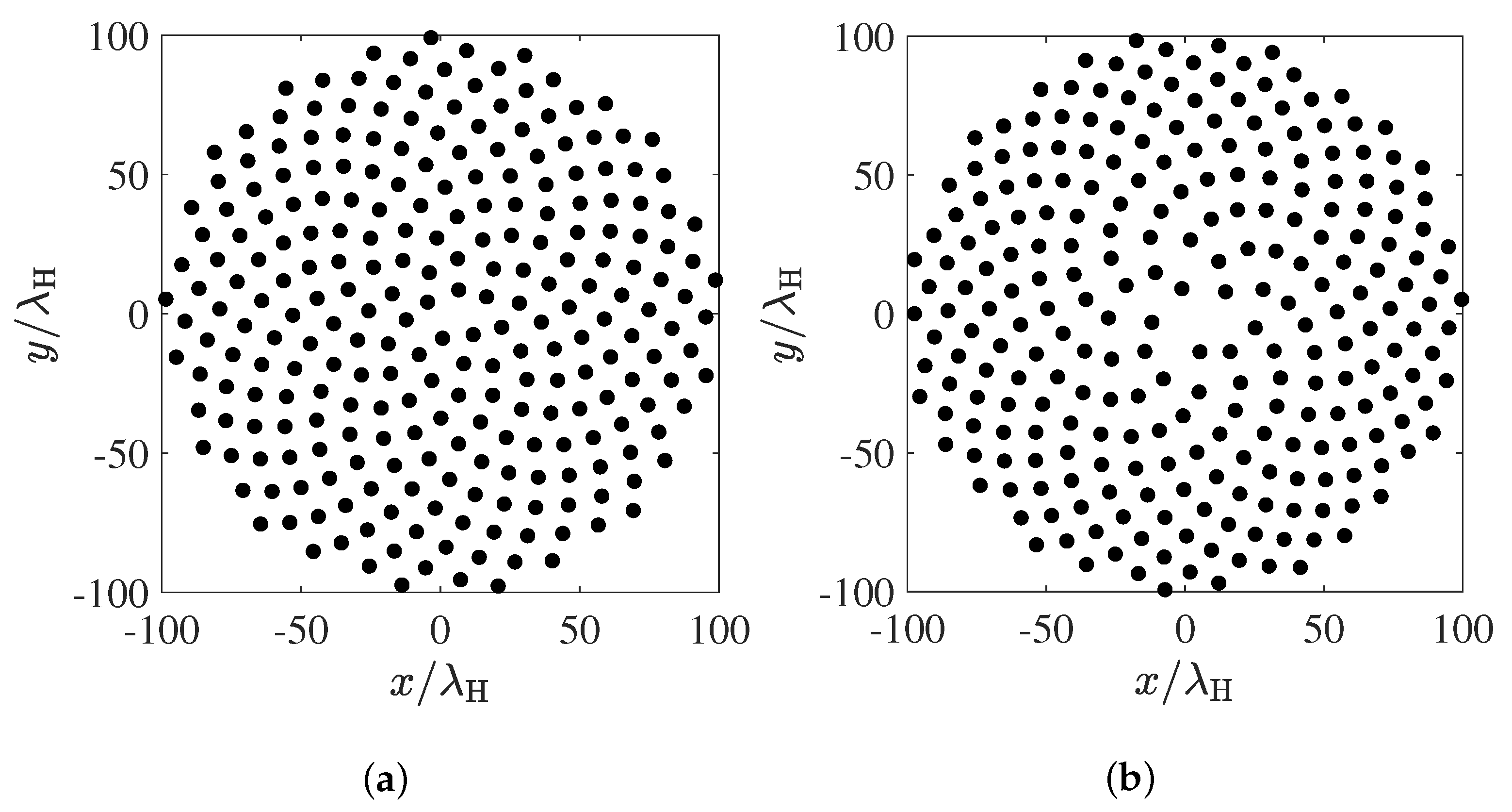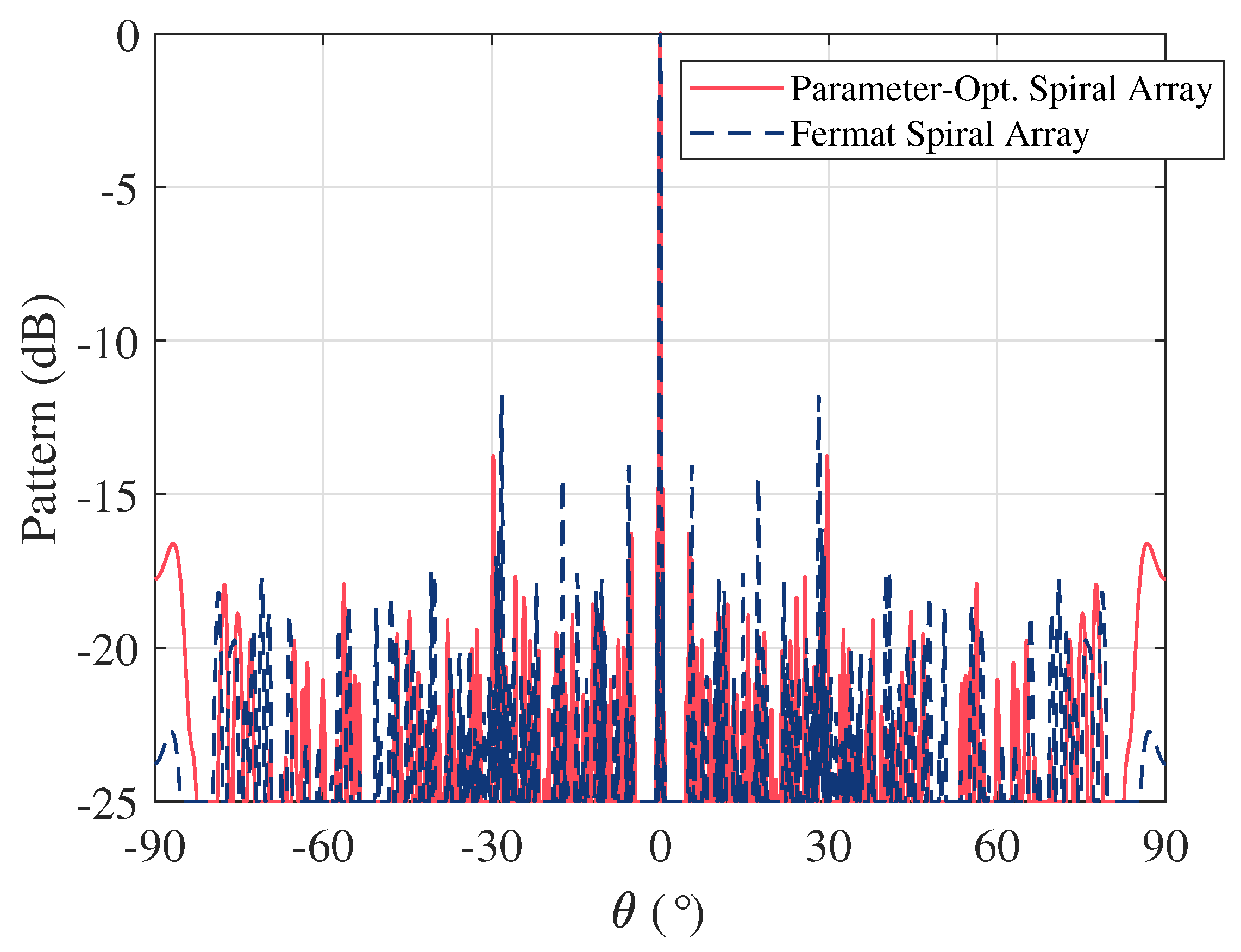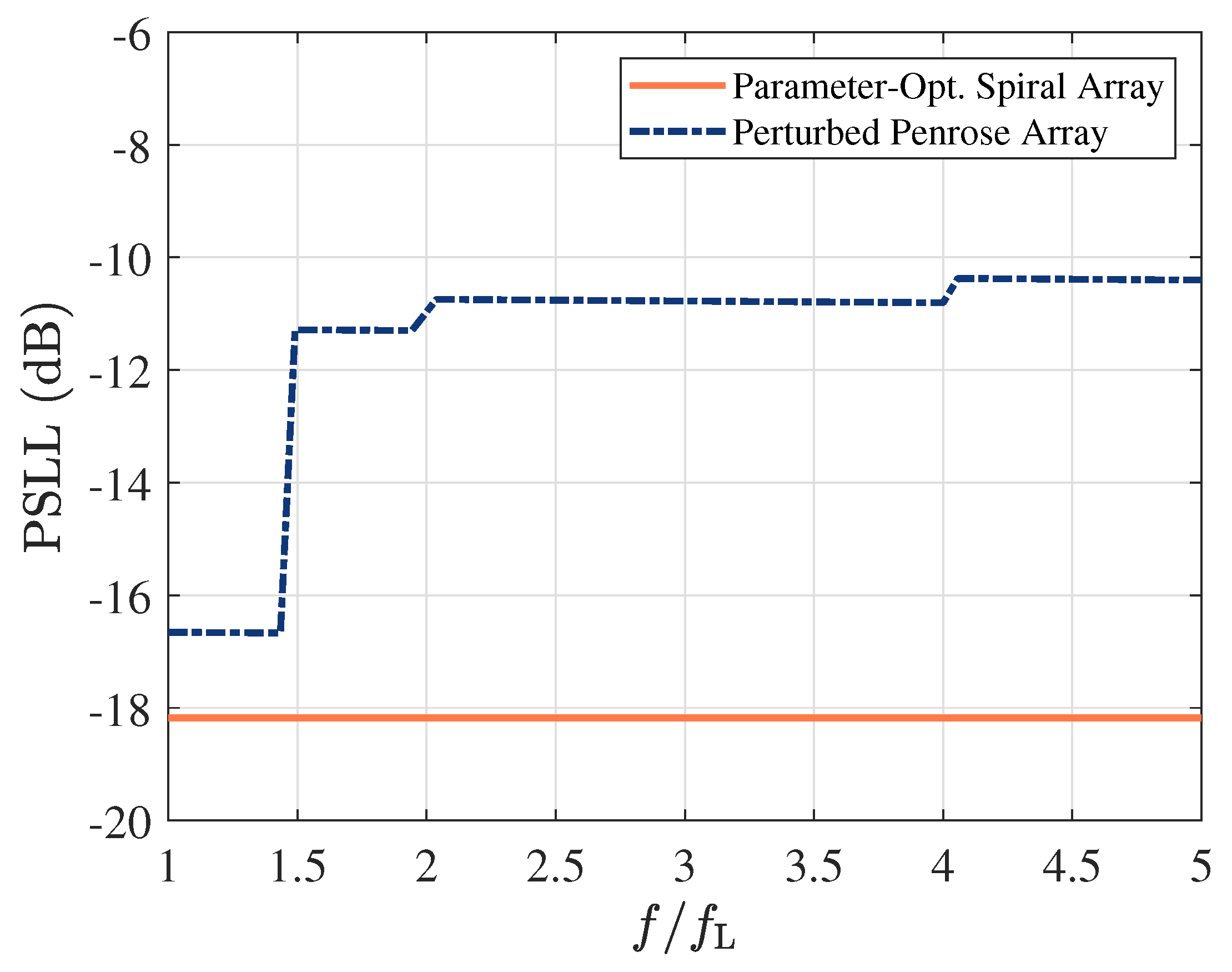Design of Parameter-Optimized Spiral Arrays with Ultra-Wideband Grating Lobe Suppression
Abstract
:1. Introduction
2. Formulation and Algorithm
2.1. General Spiral Array Model
2.2. Parameter-Optimized Spiral Array by PSO Algorithm
| Algorithm 1 The PSO-based synthesis procedure for optimizing geometric parameters of spiral array |
|
3. Numerical Results
3.1. Example I
3.2. Example II
4. Conclusions
Author Contributions
Funding
Institutional Review Board Statement
Informed Consent Statement
Data Availability Statement
Conflicts of Interest
References
- Zhang, L.; Gao, S.; Luo, Q.; Li, W.; Li, Q. Wideband dual circularly polarized beam-scanning array for Ka-band satellite communications. Microw. Opt. Technol. Lett. 2017, 59, 1962–1967. [Google Scholar] [CrossRef]
- Eldek, A.A.; Elsherbeni, A.Z.; Smith, C.E. Wideband 2D array of microstrip fed rectangular-slot antennas for radar applications. Microw. Opt. Technol. Lett. 2005, 46, 36–40. [Google Scholar] [CrossRef]
- Tzanidis, I.; Sertel, K.; Volakis, J.L. UWB low-profile tightly coupled dipole array with integrated balun and edge terminations. IEEE Antenna Wirel. Propag. Lett. 2013, 66, 3017–3025. [Google Scholar] [CrossRef]
- Zhang, L.; Gao, S.; Luo, Q.; Li, W.; He, Y.; Li, Q. A wideband circularly polarized tightly coupled array. IEEE Trans. Antennas Propag. 2018, 66, 6382–6387. [Google Scholar] [CrossRef]
- Garza, L.A.; Yepes, L.F.; Covarrubias, D.H.; Alonso, M.A.; Panduro, M.A. Synthesis of sparse circular antenna arrays applying a tapering technique over reconstructed continuous current distribution. IET Microw. Antennas Propag. 2016, 10, 347–352. [Google Scholar] [CrossRef]
- Gong, Y.; Xiao, S.; Wang, B.Z. Synthesis of sparse planar arrays with multiple patterns by the generalized matrix enhancement and matrix pencil. IEEE Trans. Antennas Propag. 2021, 69, 869–881. [Google Scholar] [CrossRef]
- Fuchs, B. Synthesis of sparse arrays with focused or shaped beampattern via sequential convex optimizations. IEEE Trans. Antennas Propag. 2012, 60, 3499–3503. [Google Scholar] [CrossRef] [Green Version]
- Lin, Z.; Chen, Y.; Liu, X.; Jiang, R.; Shen, B.; Guo, X.X. Optimized design for sparse arrays in 3-D imaging sonar systems based on perturbed bayesian compressive sensing. IEEE Sens. J. 2020, 60, 5554–5565. [Google Scholar] [CrossRef]
- Keizer, W. Linear array thinning using iterative FFT techniques. IEEE Trans. Antennas Propag. 2008, 56, 2757–2760. [Google Scholar] [CrossRef]
- Oliveri, G.; Gottardi, G.; Hannan, M.A.; Anselmi, N.; Poli, L. Autocorrelation-driven synthesis of antenna arrays-the case of DS-based planar isophoric thinned arrays. IEEE Trans. Antennas Propag. 2020, 68, 2895–2910. [Google Scholar] [CrossRef]
- Spence, T.G.; Werner, D.H. Generalized space-filling gosper curves and their application to the design of wideband modular planar antenna arrays. IEEE Trans. Antennas Propag. 2010, 58, 3931–3941. [Google Scholar] [CrossRef]
- Spence, T.G.; Werner, D.H. Design of broadband planar arrays based on the optimization of aperiodic tilings. IEEE Trans. Antennas Propag. 2008, 56, 76–86. [Google Scholar] [CrossRef]
- Gregory, M.D.; Namin, F.A.; Werner, D.H. Exploiting rotational symmetry for the design of ultra-wideband planar phased array layouts. IEEE Trans. Antennas Propag. 2013, 61, 176–184. [Google Scholar] [CrossRef]
- Vigano, M.C.; Toso, G.; Caille, G.; Mangenot, C.; Large, I.E. Spatial density tapered sunflower antenna array. In Proceedings of the 2009 3rd European Conference on Antennas and Propagation (EuCAP), Berlin, Germany, 23–27 March 2009; pp. 778–782. [Google Scholar]
- Gabrielli, L.H.; Hernandez-Figueroa, H.E. Aperiodic antenna array for secondary lobe suppression. IEEE Photon. Technol. Lett. 2016, 28, 209–212. [Google Scholar] [CrossRef]
- Malhat, H.A.; Zainud-Deed, S.H. Linearly and circularly polarized reflectarray antennas with 4-arm archimedean spiral lattice. In Proceedings of the 32nd URSI General Assembly and Scientific Symposium (GASS), Montreal, QC, Canada, 19–26 August 2017; pp. 1–4. [Google Scholar]
- Perez, J.R.; Basterrechea, J. Particle swarm optimization with tournament selection for linear array synthesis. Microw. Opt. Technol. Lett. 2008, 50, 627–638. [Google Scholar] [CrossRef]
- Dunham, D. Hyperbolic spirals and spiral patterns. In Proceedings of the Meeting Alhambra, ISAMA-BRIDGES Conference Proceedings, Granada, Spain, 23–25 July 2003; pp. 521–529. [Google Scholar]
- Eberhart, R.; Kennedy, J. A new optimizer using particle swarm theory. In Proceedings of the Sixth International Symposium on Micro Machine and Human Science, Nagoya, Japan, 4–6 October 1995; MHS’95. pp. 39–43. [Google Scholar]
- Shi, Y.; Eberhart, R. Modified particle swarm optimizer. In Proceedings of the IEEE World Congress on Computational Intelligence, Anchorage, AK, USA, 1–9 May 1998; pp. 69–73. [Google Scholar]
- Liu, F.; Liu, Y.; Han, F.; Bao, Y.L.; Guo, Y.J. Synthesis of large unequally spaced planar arrays utilizing differential evolution with new encoding mechanism and cauchy mutation. IEEE Trans. Antennas Propag. 2020, 68, 4406–4416. [Google Scholar] [CrossRef]
- Huang, Z.; Cheng, Y. Near-field pattern synthesis for sparse focusing antenna arrays based on Bayesian compressive sensing and convex optimization. IEEE Trans. Antennas Propag. 2018, 66, 5249–5257. [Google Scholar] [CrossRef]






| N | Fermat Spiral Array | Parameter-Opt. Spiral Array | ||||
|---|---|---|---|---|---|---|
| 64 | ||||||
| 128 | ||||||
| 256 | ||||||
| 512 | ||||||
Disclaimer/Publisher’s Note: The statements, opinions and data contained in all publications are solely those of the individual author(s) and contributor(s) and not of MDPI and/or the editor(s). MDPI and/or the editor(s) disclaim responsibility for any injury to people or property resulting from any ideas, methods, instructions or products referred to in the content. |
© 2023 by the authors. Licensee MDPI, Basel, Switzerland. This article is an open access article distributed under the terms and conditions of the Creative Commons Attribution (CC BY) license (https://creativecommons.org/licenses/by/4.0/).
Share and Cite
Liu, S.; Chen, L.; Liu, Y. Design of Parameter-Optimized Spiral Arrays with Ultra-Wideband Grating Lobe Suppression. Electronics 2023, 12, 1664. https://doi.org/10.3390/electronics12071664
Liu S, Chen L, Liu Y. Design of Parameter-Optimized Spiral Arrays with Ultra-Wideband Grating Lobe Suppression. Electronics. 2023; 12(7):1664. https://doi.org/10.3390/electronics12071664
Chicago/Turabian StyleLiu, Siqi, Liyang Chen, and Yanhui Liu. 2023. "Design of Parameter-Optimized Spiral Arrays with Ultra-Wideband Grating Lobe Suppression" Electronics 12, no. 7: 1664. https://doi.org/10.3390/electronics12071664






